Advanced Financial Accounting: Investment Analysis and AASB Standards
VerifiedAdded on 2022/11/25
|6
|1419
|143
Report
AI Summary
This report addresses the accounting requirements for Wakefield Ltd.'s proposed investment in Hobson Ltd., focusing on the application of AASB standards, particularly AASB 3 concerning business combinations. It details the recognition of profits, dividends, and interest, along with the accounting treatment for operating leases. The report also includes an analysis of relevant accounting standards and their impact on financial statements, emphasizing the importance of understanding business combinations. Additionally, it references academic articles to support the understanding and implementation of AASB 3. This resource, available on Desklib, provides students with a comprehensive overview of advanced financial accounting principles and practical applications.
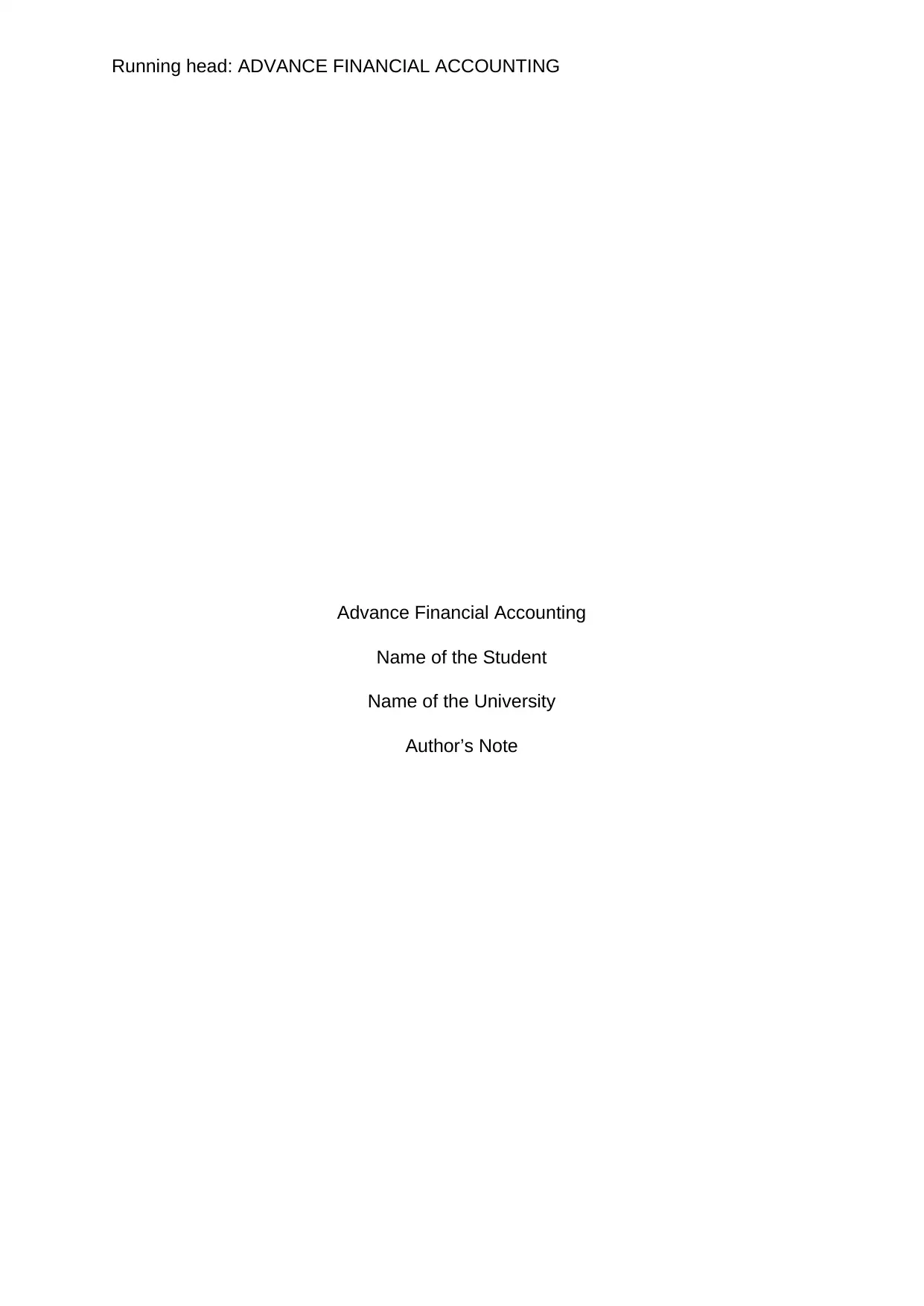
Running head: ADVANCE FINANCIAL ACCOUNTING
Advance Financial Accounting
Name of the Student
Name of the University
Author’s Note
Advance Financial Accounting
Name of the Student
Name of the University
Author’s Note
Paraphrase This Document
Need a fresh take? Get an instant paraphrase of this document with our AI Paraphraser
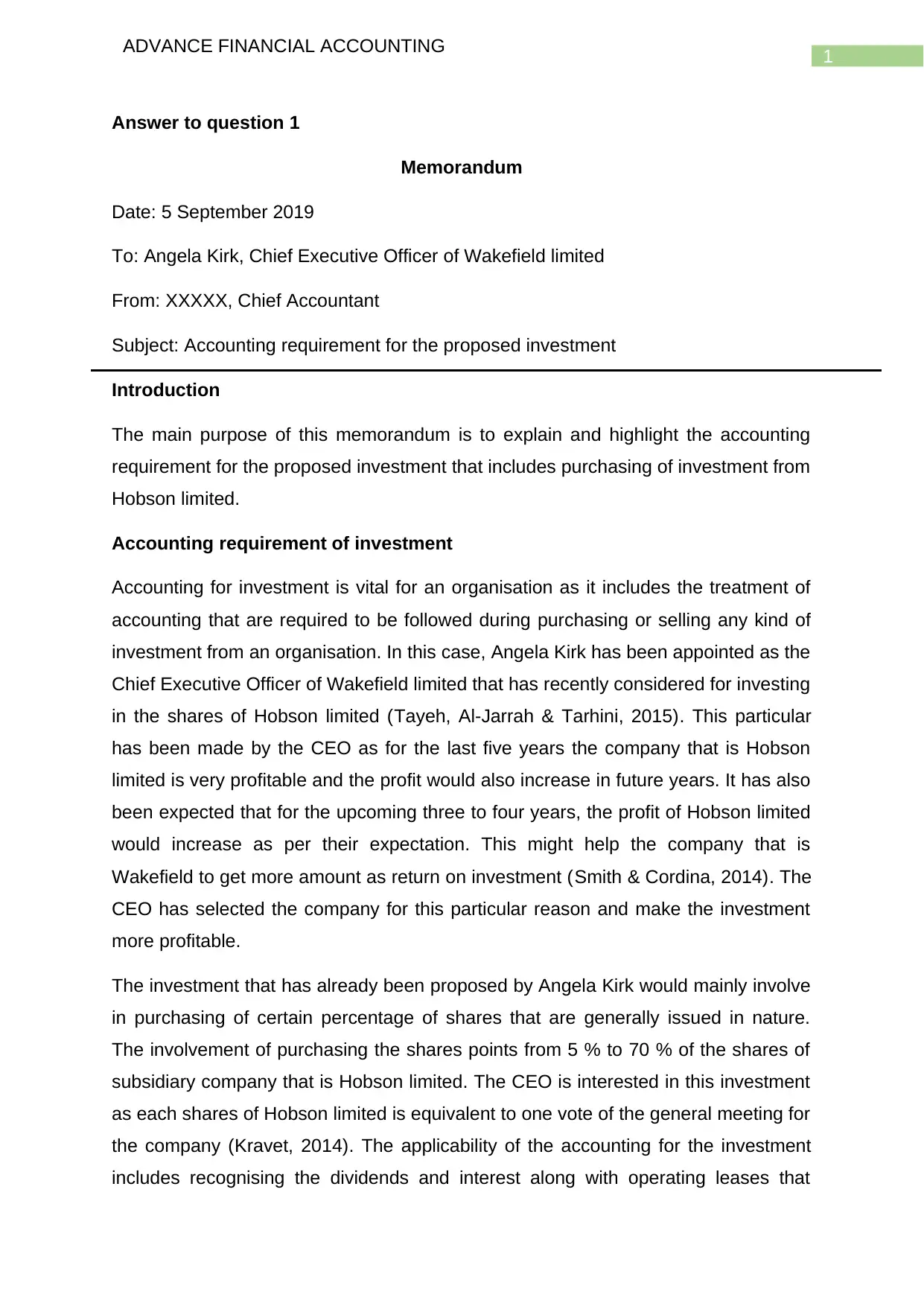
1
ADVANCE FINANCIAL ACCOUNTING
Answer to question 1
Memorandum
Date: 5 September 2019
To: Angela Kirk, Chief Executive Officer of Wakefield limited
From: XXXXX, Chief Accountant
Subject: Accounting requirement for the proposed investment
Introduction
The main purpose of this memorandum is to explain and highlight the accounting
requirement for the proposed investment that includes purchasing of investment from
Hobson limited.
Accounting requirement of investment
Accounting for investment is vital for an organisation as it includes the treatment of
accounting that are required to be followed during purchasing or selling any kind of
investment from an organisation. In this case, Angela Kirk has been appointed as the
Chief Executive Officer of Wakefield limited that has recently considered for investing
in the shares of Hobson limited (Tayeh, Al-Jarrah & Tarhini, 2015). This particular
has been made by the CEO as for the last five years the company that is Hobson
limited is very profitable and the profit would also increase in future years. It has also
been expected that for the upcoming three to four years, the profit of Hobson limited
would increase as per their expectation. This might help the company that is
Wakefield to get more amount as return on investment (Smith & Cordina, 2014). The
CEO has selected the company for this particular reason and make the investment
more profitable.
The investment that has already been proposed by Angela Kirk would mainly involve
in purchasing of certain percentage of shares that are generally issued in nature.
The involvement of purchasing the shares points from 5 % to 70 % of the shares of
subsidiary company that is Hobson limited. The CEO is interested in this investment
as each shares of Hobson limited is equivalent to one vote of the general meeting for
the company (Kravet, 2014). The applicability of the accounting for the investment
includes recognising the dividends and interest along with operating leases that
ADVANCE FINANCIAL ACCOUNTING
Answer to question 1
Memorandum
Date: 5 September 2019
To: Angela Kirk, Chief Executive Officer of Wakefield limited
From: XXXXX, Chief Accountant
Subject: Accounting requirement for the proposed investment
Introduction
The main purpose of this memorandum is to explain and highlight the accounting
requirement for the proposed investment that includes purchasing of investment from
Hobson limited.
Accounting requirement of investment
Accounting for investment is vital for an organisation as it includes the treatment of
accounting that are required to be followed during purchasing or selling any kind of
investment from an organisation. In this case, Angela Kirk has been appointed as the
Chief Executive Officer of Wakefield limited that has recently considered for investing
in the shares of Hobson limited (Tayeh, Al-Jarrah & Tarhini, 2015). This particular
has been made by the CEO as for the last five years the company that is Hobson
limited is very profitable and the profit would also increase in future years. It has also
been expected that for the upcoming three to four years, the profit of Hobson limited
would increase as per their expectation. This might help the company that is
Wakefield to get more amount as return on investment (Smith & Cordina, 2014). The
CEO has selected the company for this particular reason and make the investment
more profitable.
The investment that has already been proposed by Angela Kirk would mainly involve
in purchasing of certain percentage of shares that are generally issued in nature.
The involvement of purchasing the shares points from 5 % to 70 % of the shares of
subsidiary company that is Hobson limited. The CEO is interested in this investment
as each shares of Hobson limited is equivalent to one vote of the general meeting for
the company (Kravet, 2014). The applicability of the accounting for the investment
includes recognising the dividends and interest along with operating leases that
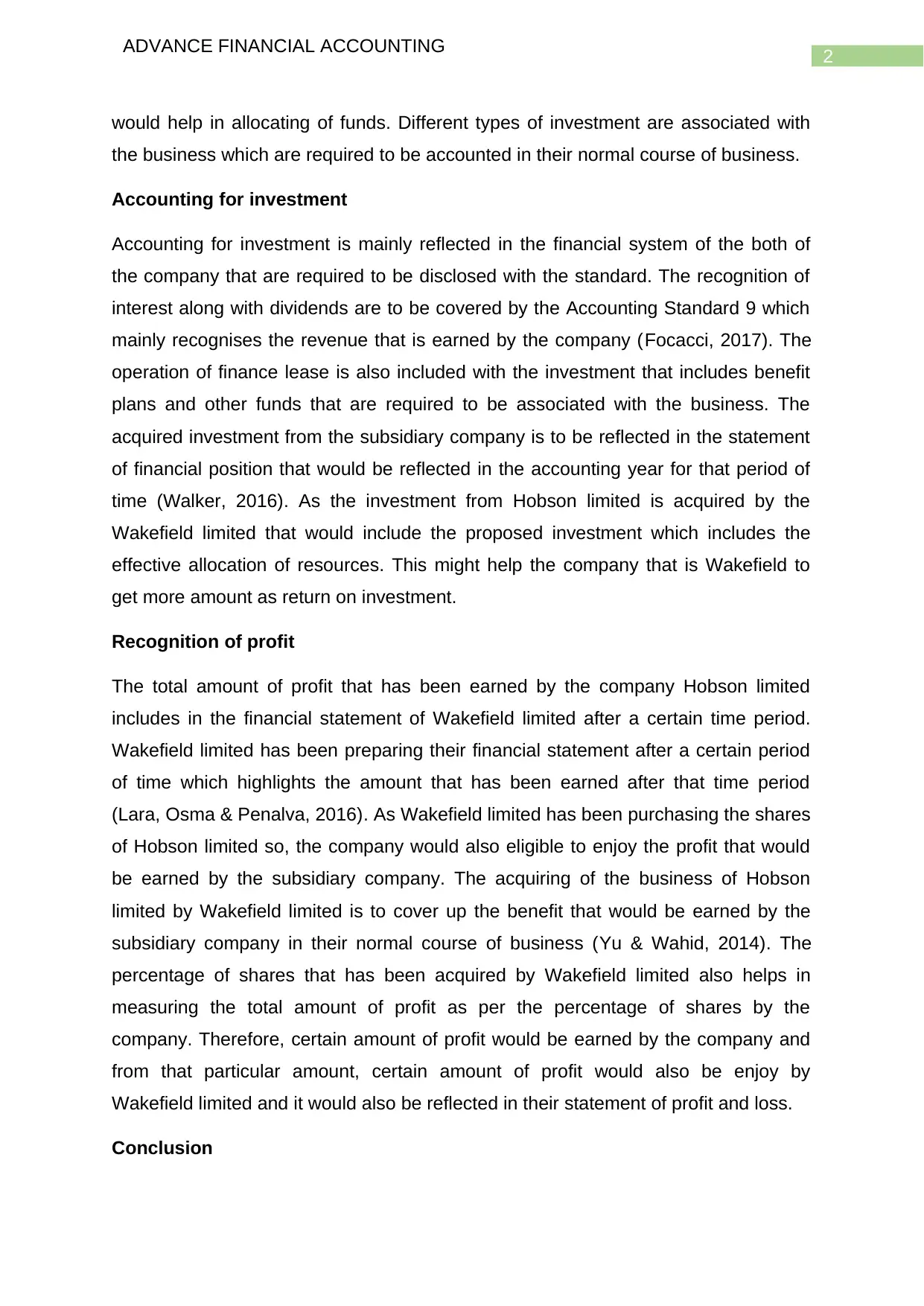
2
ADVANCE FINANCIAL ACCOUNTING
would help in allocating of funds. Different types of investment are associated with
the business which are required to be accounted in their normal course of business.
Accounting for investment
Accounting for investment is mainly reflected in the financial system of the both of
the company that are required to be disclosed with the standard. The recognition of
interest along with dividends are to be covered by the Accounting Standard 9 which
mainly recognises the revenue that is earned by the company (Focacci, 2017). The
operation of finance lease is also included with the investment that includes benefit
plans and other funds that are required to be associated with the business. The
acquired investment from the subsidiary company is to be reflected in the statement
of financial position that would be reflected in the accounting year for that period of
time (Walker, 2016). As the investment from Hobson limited is acquired by the
Wakefield limited that would include the proposed investment which includes the
effective allocation of resources. This might help the company that is Wakefield to
get more amount as return on investment.
Recognition of profit
The total amount of profit that has been earned by the company Hobson limited
includes in the financial statement of Wakefield limited after a certain time period.
Wakefield limited has been preparing their financial statement after a certain period
of time which highlights the amount that has been earned after that time period
(Lara, Osma & Penalva, 2016). As Wakefield limited has been purchasing the shares
of Hobson limited so, the company would also eligible to enjoy the profit that would
be earned by the subsidiary company. The acquiring of the business of Hobson
limited by Wakefield limited is to cover up the benefit that would be earned by the
subsidiary company in their normal course of business (Yu & Wahid, 2014). The
percentage of shares that has been acquired by Wakefield limited also helps in
measuring the total amount of profit as per the percentage of shares by the
company. Therefore, certain amount of profit would be earned by the company and
from that particular amount, certain amount of profit would also be enjoy by
Wakefield limited and it would also be reflected in their statement of profit and loss.
Conclusion
ADVANCE FINANCIAL ACCOUNTING
would help in allocating of funds. Different types of investment are associated with
the business which are required to be accounted in their normal course of business.
Accounting for investment
Accounting for investment is mainly reflected in the financial system of the both of
the company that are required to be disclosed with the standard. The recognition of
interest along with dividends are to be covered by the Accounting Standard 9 which
mainly recognises the revenue that is earned by the company (Focacci, 2017). The
operation of finance lease is also included with the investment that includes benefit
plans and other funds that are required to be associated with the business. The
acquired investment from the subsidiary company is to be reflected in the statement
of financial position that would be reflected in the accounting year for that period of
time (Walker, 2016). As the investment from Hobson limited is acquired by the
Wakefield limited that would include the proposed investment which includes the
effective allocation of resources. This might help the company that is Wakefield to
get more amount as return on investment.
Recognition of profit
The total amount of profit that has been earned by the company Hobson limited
includes in the financial statement of Wakefield limited after a certain time period.
Wakefield limited has been preparing their financial statement after a certain period
of time which highlights the amount that has been earned after that time period
(Lara, Osma & Penalva, 2016). As Wakefield limited has been purchasing the shares
of Hobson limited so, the company would also eligible to enjoy the profit that would
be earned by the subsidiary company. The acquiring of the business of Hobson
limited by Wakefield limited is to cover up the benefit that would be earned by the
subsidiary company in their normal course of business (Yu & Wahid, 2014). The
percentage of shares that has been acquired by Wakefield limited also helps in
measuring the total amount of profit as per the percentage of shares by the
company. Therefore, certain amount of profit would be earned by the company and
from that particular amount, certain amount of profit would also be enjoy by
Wakefield limited and it would also be reflected in their statement of profit and loss.
Conclusion
⊘ This is a preview!⊘
Do you want full access?
Subscribe today to unlock all pages.

Trusted by 1+ million students worldwide
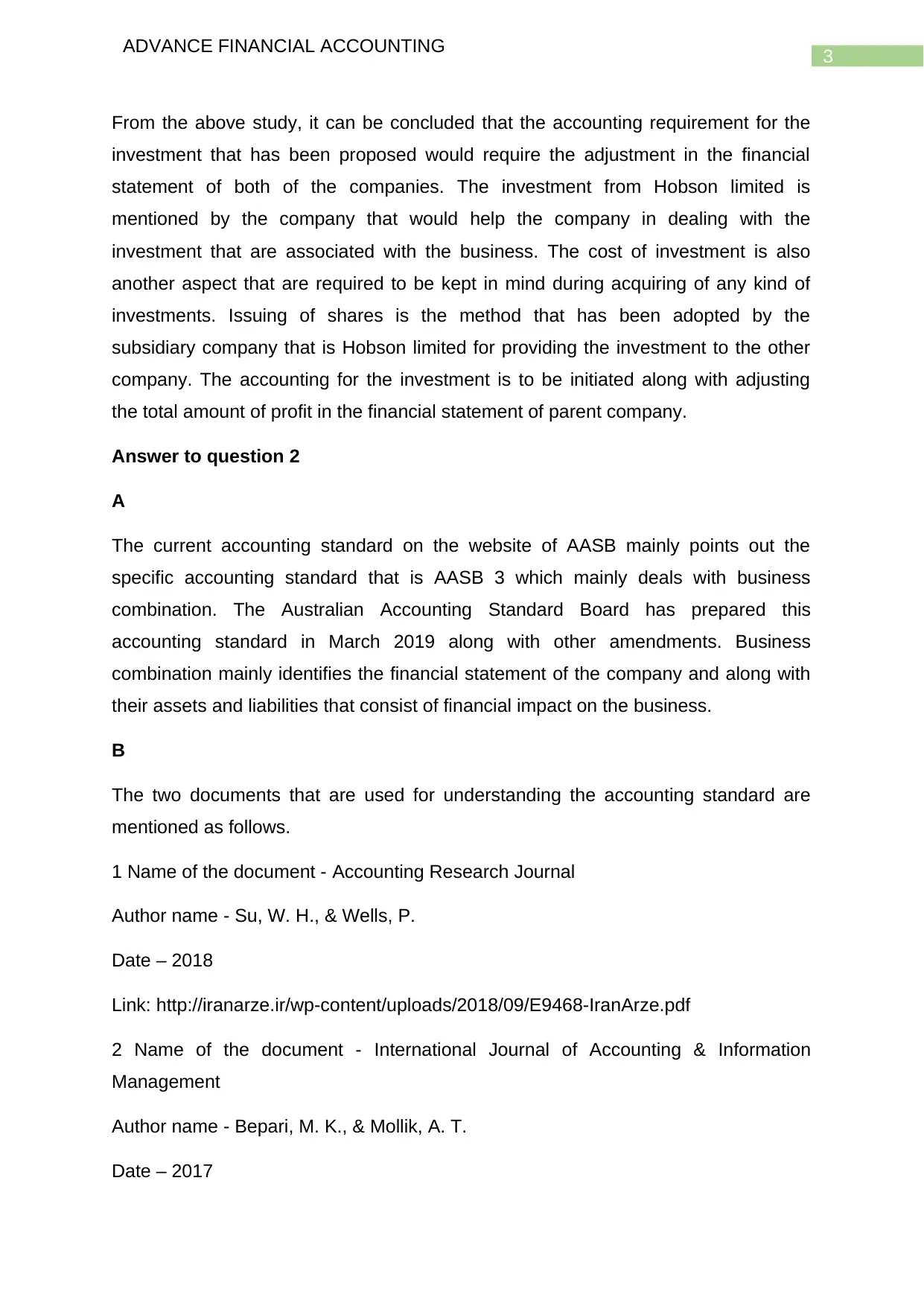
3
ADVANCE FINANCIAL ACCOUNTING
From the above study, it can be concluded that the accounting requirement for the
investment that has been proposed would require the adjustment in the financial
statement of both of the companies. The investment from Hobson limited is
mentioned by the company that would help the company in dealing with the
investment that are associated with the business. The cost of investment is also
another aspect that are required to be kept in mind during acquiring of any kind of
investments. Issuing of shares is the method that has been adopted by the
subsidiary company that is Hobson limited for providing the investment to the other
company. The accounting for the investment is to be initiated along with adjusting
the total amount of profit in the financial statement of parent company.
Answer to question 2
A
The current accounting standard on the website of AASB mainly points out the
specific accounting standard that is AASB 3 which mainly deals with business
combination. The Australian Accounting Standard Board has prepared this
accounting standard in March 2019 along with other amendments. Business
combination mainly identifies the financial statement of the company and along with
their assets and liabilities that consist of financial impact on the business.
B
The two documents that are used for understanding the accounting standard are
mentioned as follows.
1 Name of the document - Accounting Research Journal
Author name - Su, W. H., & Wells, P.
Date – 2018
Link: http://iranarze.ir/wp-content/uploads/2018/09/E9468-IranArze.pdf
2 Name of the document - International Journal of Accounting & Information
Management
Author name - Bepari, M. K., & Mollik, A. T.
Date – 2017
ADVANCE FINANCIAL ACCOUNTING
From the above study, it can be concluded that the accounting requirement for the
investment that has been proposed would require the adjustment in the financial
statement of both of the companies. The investment from Hobson limited is
mentioned by the company that would help the company in dealing with the
investment that are associated with the business. The cost of investment is also
another aspect that are required to be kept in mind during acquiring of any kind of
investments. Issuing of shares is the method that has been adopted by the
subsidiary company that is Hobson limited for providing the investment to the other
company. The accounting for the investment is to be initiated along with adjusting
the total amount of profit in the financial statement of parent company.
Answer to question 2
A
The current accounting standard on the website of AASB mainly points out the
specific accounting standard that is AASB 3 which mainly deals with business
combination. The Australian Accounting Standard Board has prepared this
accounting standard in March 2019 along with other amendments. Business
combination mainly identifies the financial statement of the company and along with
their assets and liabilities that consist of financial impact on the business.
B
The two documents that are used for understanding the accounting standard are
mentioned as follows.
1 Name of the document - Accounting Research Journal
Author name - Su, W. H., & Wells, P.
Date – 2018
Link: http://iranarze.ir/wp-content/uploads/2018/09/E9468-IranArze.pdf
2 Name of the document - International Journal of Accounting & Information
Management
Author name - Bepari, M. K., & Mollik, A. T.
Date – 2017
Paraphrase This Document
Need a fresh take? Get an instant paraphrase of this document with our AI Paraphraser
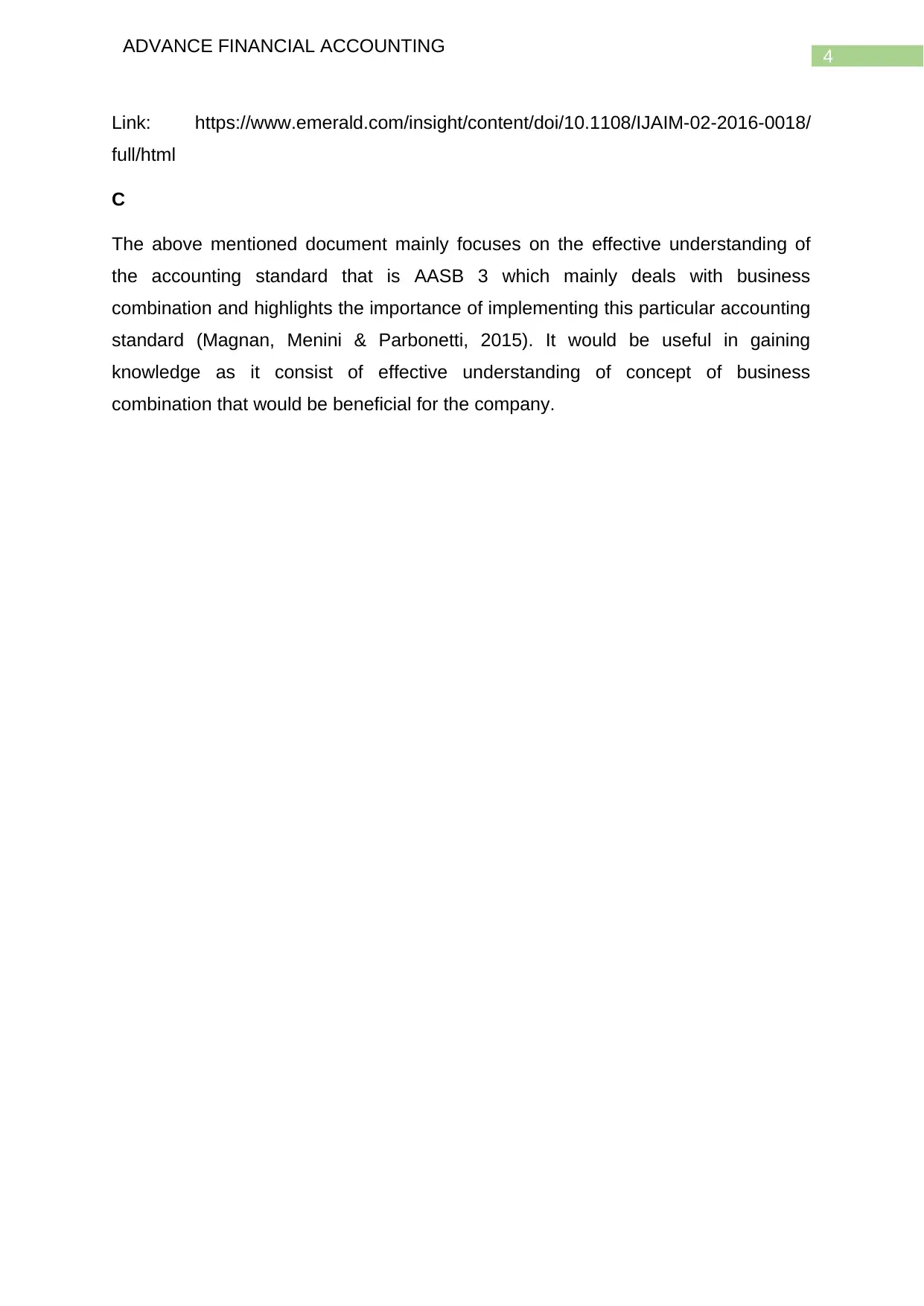
4
ADVANCE FINANCIAL ACCOUNTING
Link: https://www.emerald.com/insight/content/doi/10.1108/IJAIM-02-2016-0018/
full/html
C
The above mentioned document mainly focuses on the effective understanding of
the accounting standard that is AASB 3 which mainly deals with business
combination and highlights the importance of implementing this particular accounting
standard (Magnan, Menini & Parbonetti, 2015). It would be useful in gaining
knowledge as it consist of effective understanding of concept of business
combination that would be beneficial for the company.
ADVANCE FINANCIAL ACCOUNTING
Link: https://www.emerald.com/insight/content/doi/10.1108/IJAIM-02-2016-0018/
full/html
C
The above mentioned document mainly focuses on the effective understanding of
the accounting standard that is AASB 3 which mainly deals with business
combination and highlights the importance of implementing this particular accounting
standard (Magnan, Menini & Parbonetti, 2015). It would be useful in gaining
knowledge as it consist of effective understanding of concept of business
combination that would be beneficial for the company.
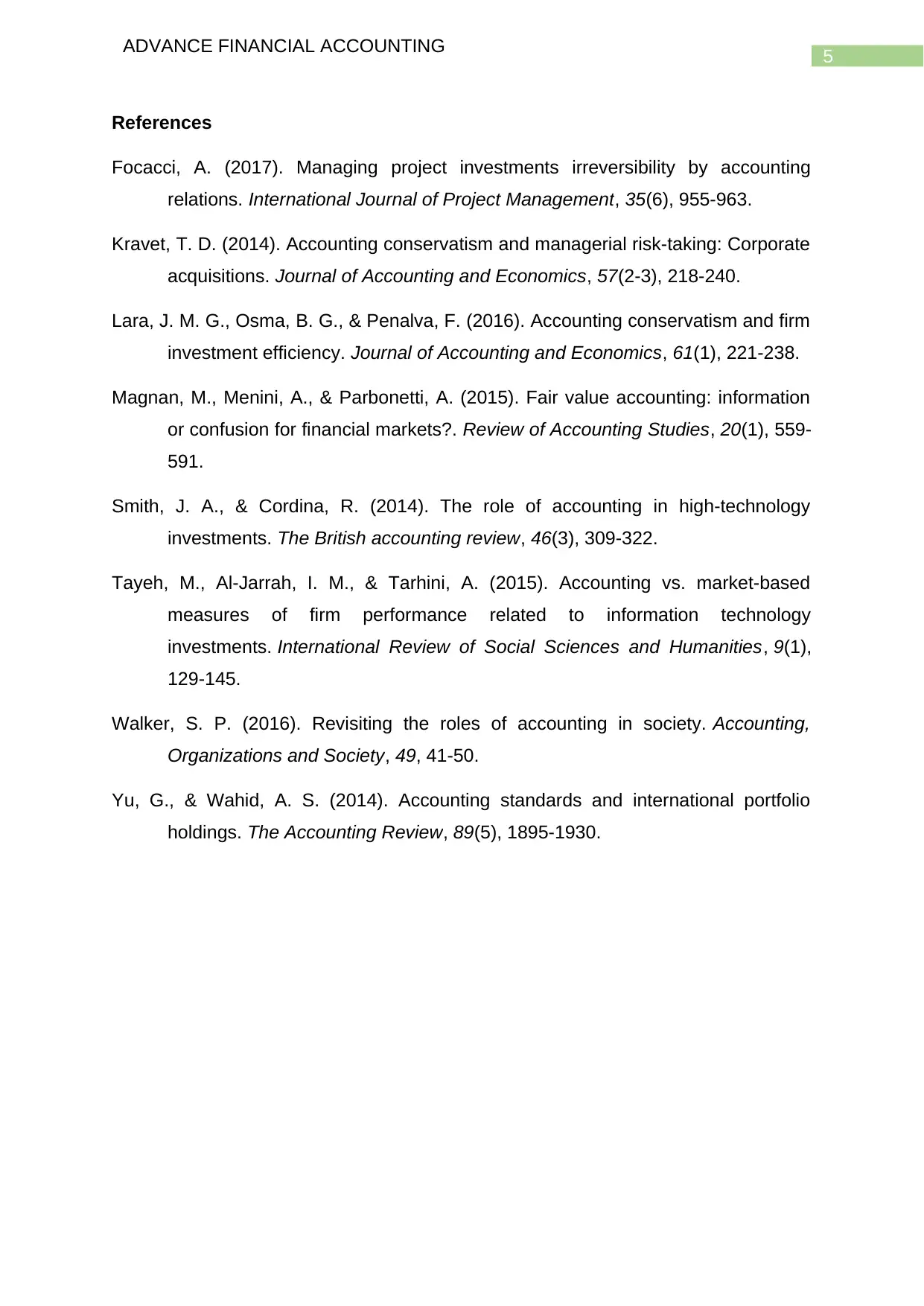
5
ADVANCE FINANCIAL ACCOUNTING
References
Focacci, A. (2017). Managing project investments irreversibility by accounting
relations. International Journal of Project Management, 35(6), 955-963.
Kravet, T. D. (2014). Accounting conservatism and managerial risk-taking: Corporate
acquisitions. Journal of Accounting and Economics, 57(2-3), 218-240.
Lara, J. M. G., Osma, B. G., & Penalva, F. (2016). Accounting conservatism and firm
investment efficiency. Journal of Accounting and Economics, 61(1), 221-238.
Magnan, M., Menini, A., & Parbonetti, A. (2015). Fair value accounting: information
or confusion for financial markets?. Review of Accounting Studies, 20(1), 559-
591.
Smith, J. A., & Cordina, R. (2014). The role of accounting in high-technology
investments. The British accounting review, 46(3), 309-322.
Tayeh, M., Al-Jarrah, I. M., & Tarhini, A. (2015). Accounting vs. market-based
measures of firm performance related to information technology
investments. International Review of Social Sciences and Humanities, 9(1),
129-145.
Walker, S. P. (2016). Revisiting the roles of accounting in society. Accounting,
Organizations and Society, 49, 41-50.
Yu, G., & Wahid, A. S. (2014). Accounting standards and international portfolio
holdings. The Accounting Review, 89(5), 1895-1930.
ADVANCE FINANCIAL ACCOUNTING
References
Focacci, A. (2017). Managing project investments irreversibility by accounting
relations. International Journal of Project Management, 35(6), 955-963.
Kravet, T. D. (2014). Accounting conservatism and managerial risk-taking: Corporate
acquisitions. Journal of Accounting and Economics, 57(2-3), 218-240.
Lara, J. M. G., Osma, B. G., & Penalva, F. (2016). Accounting conservatism and firm
investment efficiency. Journal of Accounting and Economics, 61(1), 221-238.
Magnan, M., Menini, A., & Parbonetti, A. (2015). Fair value accounting: information
or confusion for financial markets?. Review of Accounting Studies, 20(1), 559-
591.
Smith, J. A., & Cordina, R. (2014). The role of accounting in high-technology
investments. The British accounting review, 46(3), 309-322.
Tayeh, M., Al-Jarrah, I. M., & Tarhini, A. (2015). Accounting vs. market-based
measures of firm performance related to information technology
investments. International Review of Social Sciences and Humanities, 9(1),
129-145.
Walker, S. P. (2016). Revisiting the roles of accounting in society. Accounting,
Organizations and Society, 49, 41-50.
Yu, G., & Wahid, A. S. (2014). Accounting standards and international portfolio
holdings. The Accounting Review, 89(5), 1895-1930.
⊘ This is a preview!⊘
Do you want full access?
Subscribe today to unlock all pages.

Trusted by 1+ million students worldwide
1 out of 6
Related Documents
Your All-in-One AI-Powered Toolkit for Academic Success.
+13062052269
info@desklib.com
Available 24*7 on WhatsApp / Email
![[object Object]](/_next/static/media/star-bottom.7253800d.svg)
Unlock your academic potential
Copyright © 2020–2025 A2Z Services. All Rights Reserved. Developed and managed by ZUCOL.





